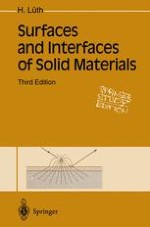1995 | OriginalPaper | Buchkapitel
Surface Phonons
verfasst von : Professor Dr. Hans Lüth
Erschienen in: Surfaces and Interfaces of Solid Materials
Verlag: Springer Berlin Heidelberg
Enthalten in: Professional Book Archive
Aktivieren Sie unsere intelligente Suche, um passende Fachinhalte oder Patente zu finden.
Wählen Sie Textabschnitte aus um mit Künstlicher Intelligenz passenden Patente zu finden. powered by
Markieren Sie Textabschnitte, um KI-gestützt weitere passende Inhalte zu finden. powered by
Classical bulk solid-state physics can, broadly speaking, be divided into two parts, one that relates mainly to the electronic properties and another in which the dynamics of the atoms as a whole or of the cores (nuclei and tightly bound core electrons) is treated. This distinction between lattice dynamics and electronic properties, which is followed by nearly every textbook on solid-state physics, is based on the vastly different masses of electrons and atomic nuclei. Displacements of atoms in a solid occur much more slowly than the movements of the electrons. When atoms are displaced from their equilibrium position, a new electron distribution with higher total energy results; but the electron system remains in its ground state, such that after the initial atomic geometry has been reestablished, the whole energy amount is transferred back to the lattice of the nuclei or cores. The electron system is not left in an excited state. The total electronic energy can therefore be considered as a potential for the movement of the nuclei. On the other hand, since the electronic movement is much faster than that of the nuclei, a first approximation for the dynamics of the electrons is based on the assumption of a static lattice with fixed nuclear positions determining the potential for the electrons. This approximation of separate, non-interacting electron dynamics and lattice (nuclear/core) dynamics is called the adiabatic approximation. It was introduced into solid-state and molecular physics by Born and Oppenheimer [5.1]. It is clear, however, that certain phenomena, such as the scattering of conduction electrons on lattice vibrations, are beyond this approximation.
